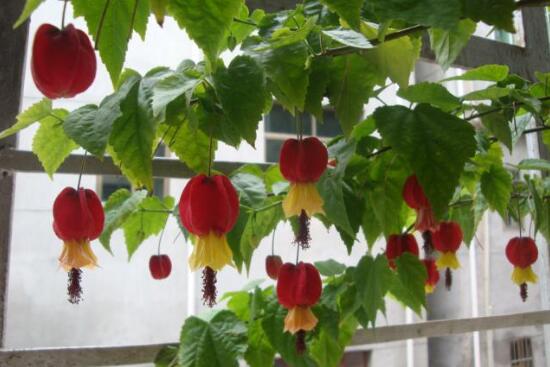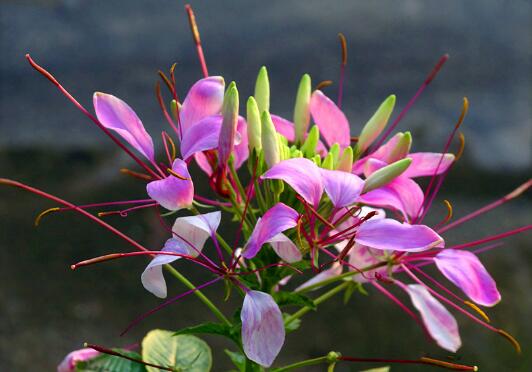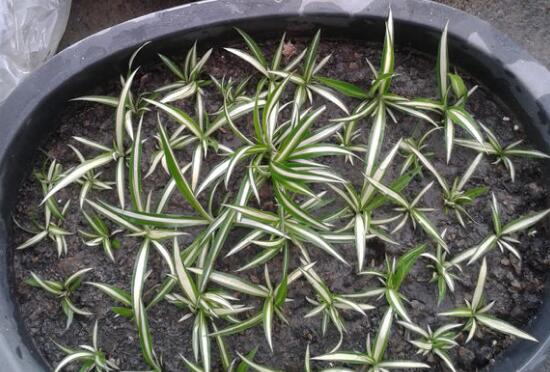How to reproduce the lantern flower? the three propagation methods of lantern flower / the fastest rooting of cuttings in spring
Lantern cage flower, also known as lantern cage flower, it flower shape strange, long like a lantern, also long like an upside down bell, looks very beautiful! Not only that, but there are many varieties of lamp cage flowers and bright colors, so they are very popular. Therefore, they are propagated in large numbers. How do lamp cage flowers reproduce? In this regard, Xiaobian found three common breeding methods of lamp cage flowers, together to learn to see.
1. How to propagate the lamp cage flower, cutting/layering/sowing

For small white, master the cultivation method of lamp cage flower can be; but for veteran, light can not be raised, but also need to know how to breed lanterns, because this can not only make a pot of lamp cage flower become more pots, but also increase the fun of breeding. As for how to propagate the lamp cage flower, there are three kinds of propagation suitable for flower friends: cuttage, layering and sowing. Specific operations, we continue to look down.
2. Three propagation methods of Menophora japonica (1) Cutting propagation methods of Menophora japonica (1)
To say how to breed lamp cage flowers, we first think of nature is cuttage, it is the most commonly used indoor potted plants, but also the most convenient breeding method, but also suitable for lamp cage flowers. The following small series will take you step by step to reproduce the lamp cage flower from the aspects of time, cutting ear, substrate, etc.
1. Cutting time
Generally speaking, except summer, the cutting of lamp cage flower can be carried out in other three seasons. However, according to the operation experience of flower growers, it is known that cutting flowers take root fastest in spring, followed by autumn, and winter temperatures are lower in many places, so it is recommended to choose spring and autumn.
2. Cutting selection
Cutting lamp cage flower, the most important part is to select cuttings, its quality will directly determine the survival rate of the entire propagation. You can choose a 1-2-year-old, healthy, pest-free branch (no lignification and tender tip) from the potted plant of lantern flower, cut it into 6-10 cm cuttings each, keep the upper 2-3 leaves, and cut off all the lower leaves.
Cutting treatment: After cutting selection, in order to improve the survival rate, it is best to soak its base in potassium permanganate solution for 30 minutes, and then insert it into the matrix after taking it out.
3. Cutting substrate
If you want to cut flowers, you naturally need soil. Generally speaking, the cutting substrate of lamp cage flower is best mixed with garden soil and river sand according to the ratio of 1:1. It stimulates the tender roots to the minimum, which is conducive to the survival of tender roots after cutting.
4. Start cutting
After doing the above work, the cutting propagation of the lamp can be officially started: the cuttings are inserted into the substrate at a depth of 1/3 or 1/2 of the cuttings. After insertion, it needs to be watered thoroughly, then placed in a bright place for management, sprayed 1-2 times a day, and half of it can take root after 20-3 days.
(2)Method for layering propagation of Chinese flowering plant
How does the lantern flower reproduce? Flower friends can also choose layering method, specific operation: in spring and autumn, select healthy branches on the potted plant of lantern flower, peel off a circle of bark from about 15-30 cm below the top (about 1 cm wide, depth to just peel off the skin).
Next, wrap the wound with a thin film 10-20 cm long and 5-8 cm wide (put some moist garden soil on it), tighten the upper and lower ends of the film, and bulge in the middle. 4-6 After a week can take root, then cut off the branches along with the roots, it becomes a new plant.
(3)Sowing and breeding method of lamp flower
After flowering, there are seeds left, so the flower can also be used to sow reproduction, but this method is slow, and more suitable for mass reproduction, so flower friends only need to understand. Specific operation: Sprinkle the seeds of lantern flower directly on the soil, control the temperature at 20~25℃, keep the moisture of the soil, put it in a cool place for cultivation, and the seeds will take root and germinate after one month.
In general, the propagation of lamp flowers, whether it is cuttings, layering, or sowing, can take root and survive, and the survival rate is very good. However, methods are dead, people are alive, so flower friends can choose methods to reproduce according to actual conditions. About the breeding method of lamp cage flower, Xiaobian introduced this, hope to bring help to everyone.
How to breed lucky trees, lucky trees three propagation methods/cutting survival rate highest
In indoor potted plants, because of the long beauty, but also means wealth, lucky tree has become the first choice for many people. As more and more people are raised, it is also multiplied in large numbers. How does the lucky tree reproduce? In this regard, small editor on the flower cultivation experience, summarized 4 common lucky tree breeding methods, among which the highest survival rate of cuttings, together to understand and see.
1. How to breed lucky trees, cutting/sowing/grafting
For Xiao Bai, it is enough to master the breeding method of lucky tree; but for veterans, it is not enough to raise it alone, but also to know how to breed lanterns, because this can not only make a pot of lucky tree become more pots, but also increase the fun of breeding. As for how to breed lucky trees, there are three kinds of propagation suitable for flower friends: cuttage, seeding and grafting. Specific operations, we continue to look down.
Two, three breeding methods of lucky trees
(1)Cuttage Propagation of Lucky Tree
① Cutting time
Lucky tree adaptability is strong, to say cutting time, basically can be carried out throughout the year. However, if you want to have a high survival rate of lucky tree cuttings, it is best to choose from May to August of each year, when its activity is the highest.
② Cutting selection
Cutting propagation, of course, the most important is cutting, its quality will directly determine the survival rate of the entire propagation. Choose cuttings for lucky trees, preferably on cloudy days or in the morning without wind: on potted lucky trees, select a healthy lignified branch, cut its length of 6 or 7 cm as cuttings, and keep one or two leaves on each cutting.
Cutting treatment: cutting cut good, remember to air for a while, so that the wound healing properly, and then you can start cutting, conditional can dip in rooting powder or rooting solution and the like. In addition, the incision below the cutting is obliquely cut at 45 degrees, and the incision above is smooth, which is beneficial to the formation of callus.
③ Cutting substrate
In the cutting propagation of lucky tree, the choice of substrate is also very important. According to the habit of lucky tree selection, Xiaobian suggested to use coarse sand, vermiculite or mixed with perlite mixed medium can also be.
4. Cuttings start
Do a good job of the above preparatory work, lucky tree cuttings can officially start: the cuttings inserted into the substrate, the depth of 15cm can be. Note that when cutting, first insert and hole with sticks and then put lucky tree in, and then hand compaction. After that, keep the pot soil moist, but do not accumulate water, shade 50%. And then in a cool place to maintain 2 to 3 months after the root can be.
(2)Seed propagation of lucky tree
After flowering, the lucky tree will bear fruit, naturally there will be seeds left, and there will be seeds that can be sown (lucky tree seeds are best sown with picking). Method: Sow the seeds of Lucky Tree on the surface of the pot soil, then cover it with 3~4cm thin soil, irrigate it thoroughly, keep the pot soil moist, and it can germinate after one week under normal circumstances.
(3)Grafting Propagation of Lucky Tree
In addition to cuttage and seeding, the propagation method of lucky tree can also be used grafting method, this method is very practical, but also to ensure the excellent characteristics of lucky tree varieties. But before the lucky tree grafting, we must first prepare three things:
① Time: Lucky tree grafting is often carried out from August to September;② Rootstock: Select 2-year-old lucky tree seedlings;③ Scion: Use 1-year-old healthy branches that have blossomed, cut off all leaves on the branches, keep 2 buds, and cut a knife on both sides of the lower end of the bud.
Grafting method: cut the rootstock 40cm away from the place, and cut it vertically in the middle of the section, and then insert the scion into the cut of the rootstock. Then cover the scion with a film bag, reproduce and rain, usually a month later can grow new buds.
In general, lucky tree vitality is strong, three kinds of propagation methods are easy to survive, but in terms of convenience and survival rate, it is also the best cutting. Of course, the method is dead, people are alive, we can choose the method to reproduce according to the actual situation. As for the breeding method of lucky tree, Xiaobian introduced this, hoping to bring help to everyone.
How to raise lamp cage flower, lamp cage flower breeding and breeding methods
The environment that the lamp cage flower likes is sandy soil with good drainage, and likes cool and humid environment. Therefore, in summer, it is necessary to pay attention to shade, and in winter, it is necessary to ensure sufficient sunshine. If the temperature exceeds 38 degrees in summer, the metabolism of the lamp flower will be slow, and its growth will be in a stagnant state. At this time, leaves and rotten roots will appear. If not cared for in time, it will cause the whole plant to die. Before planting, there should also be enough organic fertilizer. For the demand for water, winter or rainy days interval 2 to 3 days, autumn or sunny days, watering every day, and summer lamp cage flowers are in the semi-dormant period, it is necessary to control water, so as to prevent leaf loss, rotten roots and other phenomena.
1. Requirements for temperature of lamp cage flower
Winter requires warm and humid, sunny, air circulation; summer requires dry, cool and semi-cloudy conditions. Avoid heat and sultry rain and sun. The optimum temperature for the growth of the flower is 10--25℃. Winter temperatures are not lower than 5 ° C. Summer temperature reached 30℃ when the growth is very slow, 35℃ when a large number of withered death.
2. Watering and fertilizing of lamp cage flowers
In the spring and autumn season to light cage watering, to master the principle of dry see wet, in order to keep the pot soil moist is appropriate. In midsummer, the soil should be dry, and the relative air humidity should reach more than 60% by spraying water. Winter should be slightly wet, promote the growth of new shoots. Thin liquid fertilizer is applied once every 10 to 15 days in spring and autumn, and once a week in bud stage. The new plants cultivated in the spring of the first year and the current year are still normally fertilized in summer to continue flowering; the perennial old plants are in dormancy and stop fertilizing.
3. Key points for the maintenance of lamp cage flowers
One is to put the plants in shade, ventilation, cool and rain shelter; spray water on the leaves many times a day, sprinkle water on the ground, reduce the temperature and increase the air humidity. Second, the perennial old plants to implement water stop fertilizer, smooth through the dormancy period. Plants should enter the room before frost, clear the room after, room temperature should be kept above 5℃. In case of cold and snow weather, when freezing occurs outdoors, it is best to move back indoors.
4. The pot of the lamp plant is turned over to change the soil. The lamp plant grows fast.
Sufficient nutrients are required, so the basin soil should be rich in humus sandy loam. 20%~30% fully decomposed animal manure should also be added. In the growth season of hair trees, liquid fertilizer should also be applied. In the spring of each of the first three years, the pots should be turned over for soil replacement to supplement nutrients. After planting, good management can bloom in the second year. Because of the luxuriant branches and leaves, it is necessary to top them in time, maintain appropriate plant height and plant type, and due to the drooping flowering, the branches should be relatively dense.
5. Pest control
How to prevent and control pests is very important. When cultivated indoors, if the ventilation is poor, it is easy to make the young stems and leaves suffer from aphids and whiteflies. When it occurs, it can be prevented by spraying 200 times solution of omethoate.
Light cage flower cultivation matters summer shade
In summer, if the temperature exceeds 30 ° C, avoid strong sunlight exposure, during the day can be moved to a cool and ventilated place under the balcony, after sunset and then moved to the balcony (preferably placed in shade or shade). Move pots from the south balcony to the north balcony in advance to avoid the sun. Put the potted plants in a large bamboo basket or carton, surrounded by soft pot soil to prevent the pots from being directly baked by the sun.
temperature increase and temperature decrease
Put half or the whole brick into the container, fill the container with clean water (water should be higher than the brick surface), and then put the pot plant on the brick, which can cool down for a long time. Move the potted plants downstairs to a ventilated and dark place, dig a small pit underground, bury the potted plants in the soil, and wait until autumn to place the potted plants indoors. Once the potted plants are heated by the sun, do not water the leaves and flowerpots before they dissipate heat, in case of uneven heat and cold, resulting in accidental damage. During the heatstroke prevention and cooling period, due to the reduction of light, control watering, do not over-frequent, often keep the basin soil moist.
prevent rain
Summer is rainy season, rain before, to put pots and plants in shelter from rain, such as thunderstorm too late to move pots, should be timely pour out the water in the pot. If the pot is still too wet at this time, the burnt charcoal powder can be sprinkled on the surface of the pot to evaporate part of the excess water. If the water in the basin soil evaporates for a long time, the basin soil is too wet, which can easily lead to deciduous and rotten roots, resulting in the death of the whole plant.
1. Cutting method of lantern flower
Except summer dormancy period can be carried out throughout the year, spring cuttings are better, rooting survival rate is high and fast. How to raise the lamp cage flower? Select a strong top shoot, 7-8 cm long, with 2-3 nodes, cut off the base leaves, insert in the sand bed, often spray to keep wet, about 10 days can take root, after 1 month can be on the pot.
2, lamp cage flower seeding method
Spring and autumn can be carried out. Autumn at 15-20℃ temperature, 15 days can germinate. How to raise the seedlings sown in spring, the second year can bloom.
- Prev

How to reproduce the drunken butterfly flower, the propagation method / sowing propagation / cutting propagation
Drunken butterfly flower is a kind of highly ornamental plant, and there are many people who raise it in me. However, with the increase in the number of farmers, people are more curious about their reproductive problems. So how do drunken butterflies reproduce? What are the breeding methods of drunken butterfly flowers? Next, the editor will take you to learn about it.
- Next

How to breed golden heart spider orchid, golden heart spider orchid two kinds of propagation methods (cuttings/ramets)
As a common indoor potted plant, the effect of golden heart spider plant is very strong, it not only looks good, but also absorbs formaldehyde, and has a good use in medicine. Such plants, naturally popular, become the pursuit of many flower friends, it is also a large number of breeding. So, how does the golden spider plant reproduce?
Related
- Fuxing push coffee new agricultural production and marketing class: lack of small-scale processing plants
- Jujube rice field leisure farm deep ploughing Yilan for five years to create a space for organic food and play
- Nongyu Farm-A trial of organic papaya for brave women with advanced technology
- Four points for attention in the prevention and control of diseases and insect pests of edible fungi
- How to add nutrient solution to Edible Fungi
- Is there any good way to control edible fungus mites?
- Open Inoculation Technology of Edible Fungi
- Is there any clever way to use fertilizer for edible fungus in winter?
- What agents are used to kill the pathogens of edible fungi in the mushroom shed?
- Rapid drying of Edible Fungi

